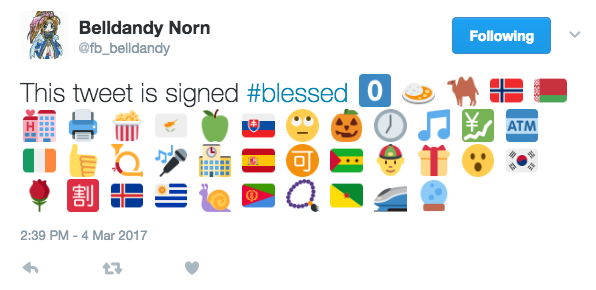What is it?
A silly project to learn unicode, baseEmoji is a base1024 encoding scheme that uses emoji as its lookup table. The primary purpose is to represent otherwise ugly data in more “pleasing” form in social media.
Use Case
The impetus for this module was to represent digital signatures in social media in a less obtrusive way. A signature on a tweet from a user to a bot is useful in alerting the bot to run commands that can be trusted to have come from a specific source. However, these signatures look like jibberish to human readers. Instead, this signature could be represented by emoji using baseEmoji and appear to a human reader like a typical Instagram user.
“Practical” Example: Signing a Tweet
Signing
import sys
import tweepy
import baseEmoji
from ecdsa import SigningKey
CONSUMER_KEY = '********'
CONSUMER_SECRET = '********'
ACCESS_KEY = '********'
ACCESS_SECRET = '********'
#set up tweepy and connect to Twitter
auth = tweepy.OAuthHandler(CONSUMER_KEY, CONSUMER_SECRET)
auth.set_access_token(ACCESS_KEY, ACCESS_SECRET)
api = tweepy.API(auth)
#create a signing key. In practice this would be saved
signKey = SigningKey.generate()
#our message
message = "This tweet is signed"
#sign the message
signature = signKey.sign(message)
#convert the signature into an emoji signature
emSig = baseEmoji.encodeStr(signature," ")
#create the tweet with a delimiter for later parsing
tweet = message + " #blessed " + emSig
#send the tweet
t = api.update_status(tweet)
#...
Viewing

Verifying
#...
#get the verification key
verifyKey = signKey.get_verifying_key()
#retrieve a tweet (in this case the tweet we just sent)
v = api.get_status(t.id)
#split the text of the tweet into the message and the signature
(rmessage,remSig) = v.text.split(" #blessed ",1)
#convert the emoji signature back to its original form
rsignature = baseEmoji.decodeStr(remSig," ")
#verify that the signature is valid for the message
assert verifyKey.verify(rsignature, rmessage)
In the wild, it may be advantageous to use a smaller digital signature algorithm and to also check that the length of the message plus the delimiter and signature don’t go beyond 140 characters. While the signature itself can be a fixed size of bytes, because some emoji require more than one code point, the emoji signature could be a few characters longer according to Twitter’s counting.
